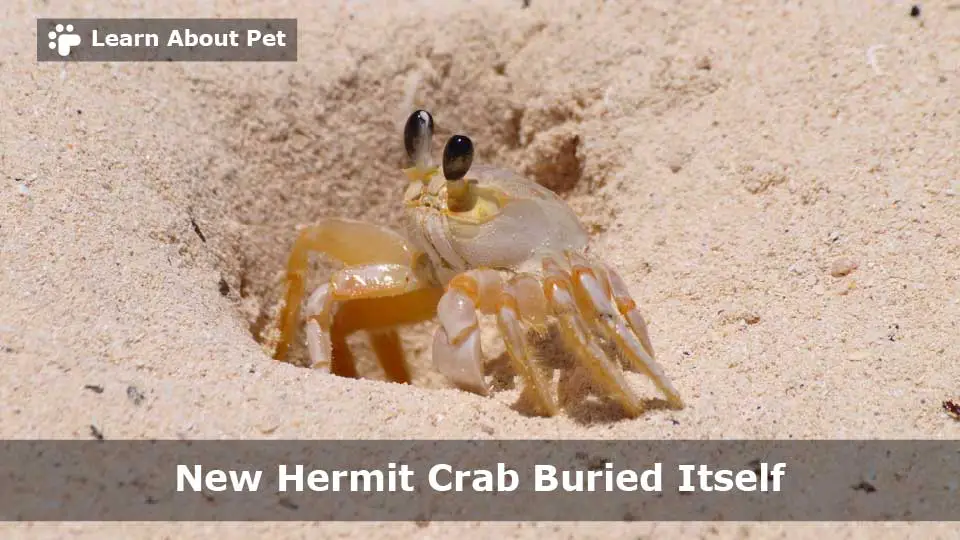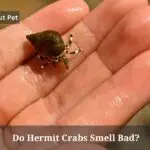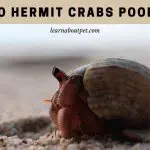Land hermit crabs are excellent because they are very social and easy to care for, and they live a long time. However, there are a few things that confuse new owners. One of these is the crab burying itself in its substrate. Why does it do this, and what should do you do about it?
If you noticed that your new hermit crab buried itself, there are two main reasons why hermit crabs bury themselves and that is for camouflage and protection from predators. Crabs feel safe when buried because then the threat will not easily spot them which makes them feel safe, especially when they are in a new environment.

New Hermit Crab Buried Itself
Some hermits may dig themselves into the sand with nothing showing but their eyes, or they will bury themselves completely except for the tip of one claw that sticks out of the sand. They might also bury themselves under a piece of rock or some other object. Once you find your new hermit crab buried itself, don’t move him unless he is in danger of being stepped on by another tank mate.
Why would a hermit do this? Crabs do this when they are preparing to molt (shed their old shell). The molt can take from three days to three months depending upon how large the crab is going to get with its new shell.
Why Does My New Hermit Crab Bury Itself?
If you keep a hermit crab as a pet, it is important to understand the behavior of burying. By understanding it, you can take steps to make sure that your pet stays healthy and active.
Concerning why do my hermit crab bury itself, whether they live in the wild or in captivity, hermit crabs need to bury themselves to get rid of their old skin as well as to thrive on moisture. This is especially true for captive hermit crabs because they do not have access to natural water sources and may have difficulty maintaining a high level of moisture.
What Should I Do When My Hermit Crab Buries Itself?
What should I do if my hermit crab buried itself? When your hermit crab buries itself, leave it alone and give it time to go about its burrowing business. Crabs are adapted to burrowing when they feel threatened, when the temperatures are extreme and when they are molting. In that case, it is necessary that you give them time to stay buried because there is nothing wrong with and in fact, it is good for them because it keeps them safe.
Concerning your new hermit crab buried itself, Crabs will also bury themselves for some time when they are molting. Molting is the process where hermit crabs shed the old exoskeleton and grow a new one, so they can grow bigger, and t’s a natural process that occurs several times throughout their lives.
During the molting process, crabs go through various molting stages before shedding their old exoskeleton completely and being vulnerable for up to a few days until the new exoskeleton hardens, which is why it’s very important to not disturb them during this time.
Before, during, and after molting periods all hermit crabs have to have access to a moist area (humidity above 80%) and should never be placed in saltwater because it dries out their gills.
How Long Do Hermit Crabs Bury Themselves In The Sand?
You might be wondering why and how long do hermit crabs stay buried when you realized that your new pet hermit crab has buried itself for a long time under the sand. The good news is that this is normal behavior for hermit crabs. If food is present, the hermit crab will bury itself to eat.
Also, Hermit crabs will bury themselves if they are scared or feel threatened as well as when molting to protect their soft shell from predators. In another case, if a hermit crab is getting ready to mate, you will find that the new hermit crab buried itself, because as part of the process.
New crab buried itself within hours of being placed in tank
If you can’t see your hermit crab because the new hermit crab buried Itself. burrowing is an instinctive behavior for them, providing safety and protection. They dig underground to hide from predators. This behavior is also necessary for them to fully complete the molting process.
New crabs are all Burying themselves when they feel that they are in a new territory and if they feel threatened by a potential predator. In that case, they’ll bury themselves in the sand and will only surface when they are safe.
Why Do Crabs Bury Themselves For A Day Or Two?
If you are wondering why do Hermit Crabs burrow themselves The main reason why a hermit crab buries itself is to protect itself from predators.
If the crab feels threatened by another animal, such as a bird or cat, it will quickly bury itself in its shell to stay safe. Hermit crabs also bury themselves during the night to stay protected while they sleep.
New hermit crab buried itself because it did not feel uncomfortable because of the heat or cold temperatures. Hermit crabs cannot control their body temperature as humans can, so they adapt to the weather conditions around them by burying themselves.
If temperatures are not favorable for the crab, it will burrow itself for long probably a day or two until the weather conditions are favorable for it and so you shouldn’t worry too much about why hermit crabs have not resurfaced.
Crabs do this as a natural adaptation to weather changes because otherwise, some could die because of temperature extremes.
Why Does My Hermit Crab Bury Himself In Substrate?
You may have thought to yourself; my new hermit crab buried itself underground. Hermit crabs have a soft, vulnerable abdomen that’s protected by the hard shell of a snail which makes them susceptible to predation, so they tend to bury themselves in the substrate when not foraging for food.
The shells of hermit crabs are usually larger than their bodies; this allows them to grow as they mature.
The most common reason why a new hermit crab buried itself, in substrate is when they lose a shell.
They need to bury themselves to protect their vulnerable abdomens which means that the only time when to start worrying about buried crabs is when you see don’t see them completely in a couple of days even when the temperatures are optimum.

Why Did All My Crabs Bury Themselves?
My hermit crab buried himself in substrate mainly because Hermit crabs are known for their ability to change shells as they grow through molting.
Their soft abdomen cannot be left exposed as it would be vulnerable to predators, so they search for a shell that will provide adequate protection and then carry it around on their backs.
If you have an aquarium with hermit crabs, you may have witnessed them burying themselves in the sand and wondered, why all my crabs buried themselves.
There are several reasons why hermit crabs bury themselves, including molting which is part of the normal lifecycle of a crab.
Hermit crabs remove their exoskeleton when it becomes too small because they continue growing throughout their life.
If your new hermit crab buried itself there is no cause for alarm because Hermit crabs bury themselves while molting because it provides extra protection while they are soft and vulnerable during this process.
Hermit crabs also burrow into the sand when they want to feel safe from predators. It also shelters them from the elements and helps them to conserve energy. Crabs like to stay in a moist environment, so burying in the sand can help them to remain hydrated.
Finally, Hermit crabs can sleep up to 12 hours a day and often bury themselves to get some rest.
Why Do My Hermit Crabs Burrow In The Sand?
If you are asking, is something wrong with our new hermit crabs because they keep burrowing themselves in the sand, there are two reasons.
According to the United States Geological Survey, scientists and other experts are divided on the reason why living hermit crabs bury themselves in the sand they offer two theories and one theory suggests that the crab buries itself to scout out a new shell.
While buried, the hermit crab can feel around for a new shell that might be empty. If it finds one, it returns to its current shell and crawls into the new one as soon as it can.
The other theory about why do hermit crabs burrow suggests that hermit crabs bury themselves for protection when they are molting or shedding their outer layer of skin and exoskeleton.
This process is similar to a snake shedding its skin, except that crabs shed their entire exoskeleton at once.
The crab is vulnerable during this process and new hermit crab buried itself protects it from predators until it has had time to harden its new exoskeleton.
My Hermit Crab Buried Himself And Won’t Come Out
You could be wondering how long do hermit crabs bury themselves and why. There are several reasons why hermit crabs bury themselves in the sand.
First, you should know that hermit crabs are not actually “hermit” or solitary creatures. They live in groups, and they often dig burrows for multiple crabs. Hermit crabs have soft bodies and need a hard shell to protect them from predators.
Crabs typically wear the discarded shells of other animals (usually snails). They will also bury themselves in the sand to molt or shed their old exoskeletons.
So if you are worried that my crab buried himself and won’t come out then you should know that main it to protect himself.
Why Does The Hermit Crab Bury Itself?
Concerning why is my hermit crab burying itself, one of the reasons why hermit crabs buried themselves is because they are stressed. If you notice that your hermit crab is spending most of his time hidden in his shell, it might be a sign that something is wrong.
Another possible reason for burying behavior is that hermit crabs are nocturnal animals. They spend most of their time sleeping during the day, so if you see that your crab is hiding in his shell at night, chances are he’s just sleeping and not stressed out.
Why Are Crabs Burying Themselves?
If you are worried if, do hermit crabs bury themselves to die, the most common reasons why crabs will bury themselves in the sand is for defense and the process of molting.
As a hermit crab grows, it needs to shed its shell and form a new, bigger one. If you find that your new hermit crab buried itself, it’s okay because often buries itself in the moist sand while it’s molting so that it doesn’t become dehydrated.
As to why do crabs bury themselves in the sand, a crab burrows in the sand during molting which happens on average once per year for land-based hermits and more frequently for species that live near the water.
Molting can be triggered by different variables depending on the type of crab. For example, some crabs molt when their old shell becomes too small for them or when they sense another hermit is about to attack them.
Final Verdict – New Hermit Crab Buried Itself
It is in the nature of hermit crabs to bury themselves in the sand. They do so as a way of defense as well as for survival through molting. Hermit crabs specifically will burrow themselves when they are put in a new environment.
They do this to ensure that they are safe by getting away from any potential threats that could pose a risk to them.

You don’t have to worry if you don’t find your crab at the surface for several hours or even for one or two days. The hermit is just fine only that it needs time to feel safe and familiarized with the environment.
After the hermit crab is done with molting and it feels safe you will see it quite often.
As a pet lover, make sure to learn about pet more and give your pet hermit crab a good and comfortable life!

Welcome to Learn About Pet. My name is Rajkumar Ravichandran and I love all pets, travel, and amazing food. I write about my passion and personal experience caring for multiple pets in this blog! ❤️
Post Disclaimer
DISCLAIMER: THIS BLOG OR WEBSITE, "Learn About Pet", DOES NOT PROVIDE YOU WITH MEDICAL ADVICE AND IS NOT A SUBSTITUTE FOR MEDICAL ADVICE. ALWAYS GET IN TOUCH WITH YOUR PERSONAL VETERINARIAN AND USE INFORMATION HERE AS GENERAL ADVICE.
The information, including but not limited to, text, graphics, images and other material contained on this website are for informational purposes only. No material on this site is intended to be a substitute for professional veterinary advice, food recommendation, diagnosis, or treatment. Always seek the advice of your veterinarian or other qualified health care provider with any questions you may have regarding a medical condition or for pet food related questions.







